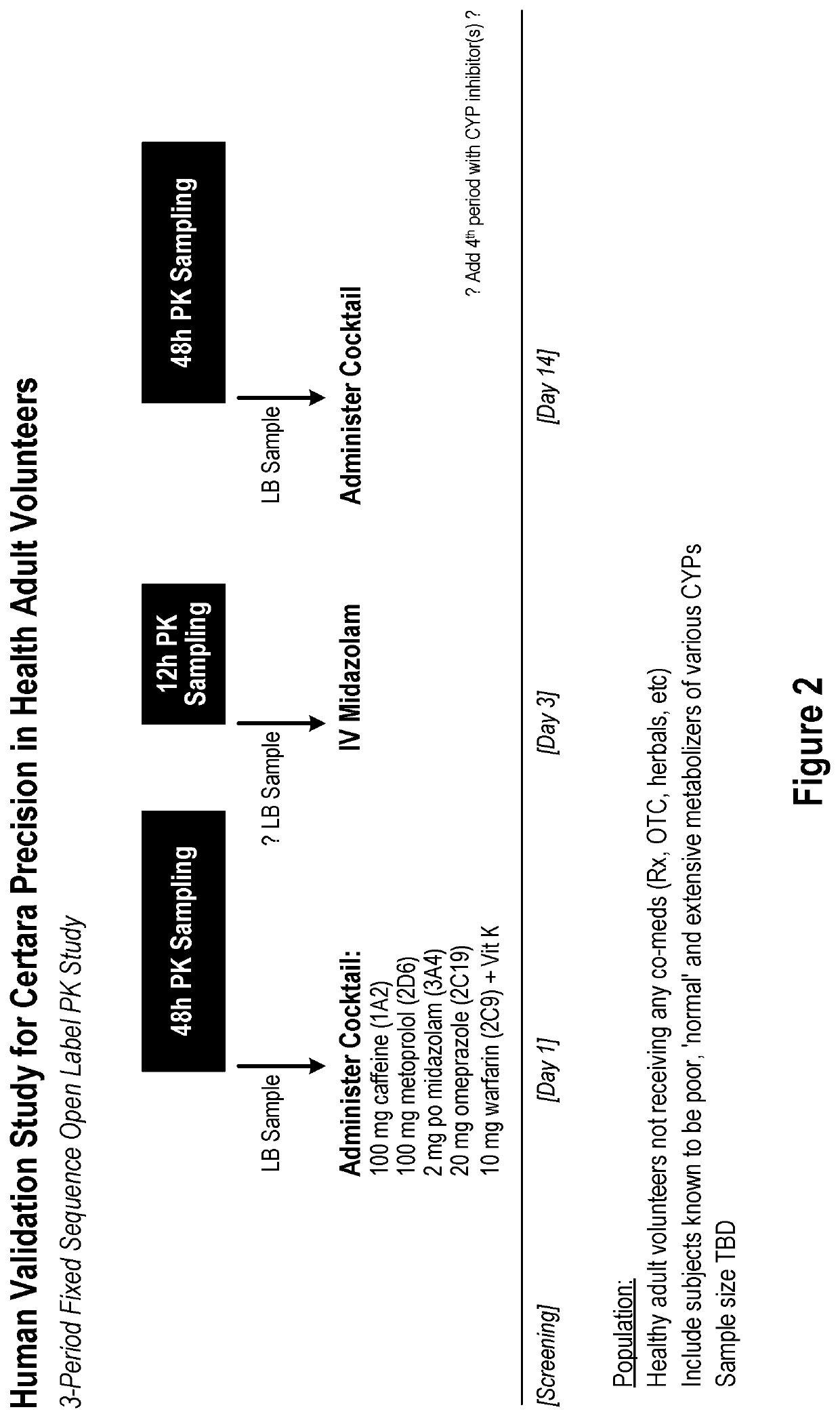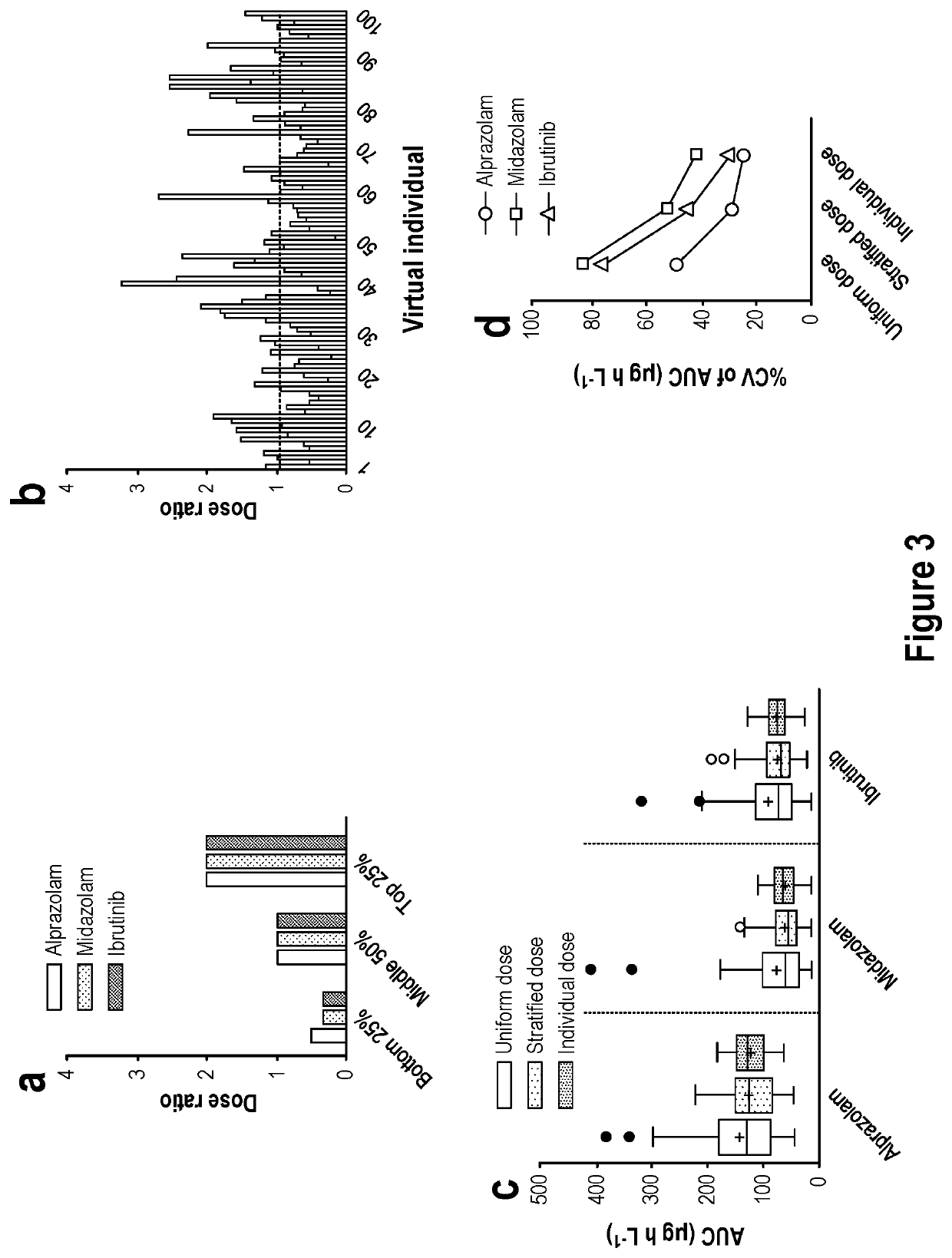Methods and apparatus for generating a virtual model of xenobiotic exposure using transcriptomics analysis of liquid biopsy samples
a transcriptomics and liquid biopsy technology, applied in the field of methods, can solve problems such as difficult and ethically challenging to explore complex clinical scenarios, unpredictability, and impracticality of individuals being subjected to invasive biopsy procedures to harvest tissue, and achieve the effects of reducing variation in correlation of other variables, reducing the risk of infection, and easy detection and quantification
- Summary
- Abstract
- Description
- Claims
- Application Information
AI Technical Summary
Benefits of technology
Problems solved by technology
Method used
Image
Examples
example 1
[0155]The following example provides a protocol for total RNA extraction from samples of blood that can be used to determine the levels of RNA for drug metabolizing enzymes, transporters and / or marker genes in the samples, and / or RNA for the determination of biomarkers. Methods for the isolation of total protein and quantification of enzymes and transporters are described herein for the assessment of correlation between plasma RNA and tissue protein levels.
RNA Analysis of Liquid Biopsy Comprising Blood
A. Blood Samples
[0156]A liquid biopsy consisting of fresh peripheral venous blood may be collected from a subject and plasma isolated before further processing as described below. If required, peripheral blood mononuclear cells (PBMCs), including B and T lymphocytes, may be isolated using Ficoll-Paque PLUS (GE Healthcare Life Sciences).
[0157]Isolated plasma is stored frozen −80° C. until used for cell free RNA (cfRNA) isolation and measurement. Isolation of circulating or exosomal RNA ...
example 2
[0161]The following example provides a protocol for determining the degree of RNA shedding into circulation from hepatocytes in a particular subject, so establishing a robust and significant correlation function between hepatic protein levels and the corresponding plasma RNA concentrations.
[0162]Marker genes: A1BG (Alpha-1-B glycoprotein), AHSG (alpha-2-HS-glycoprotein), ALB (Albumin), APOA2 (Apolipoprotein A-II), C9 (Complement component 9), CFHR2 (Complement factor H-related 5), F2 (Coagulation factor II (thrombin)), F9 (Coagulation factor IX), HPX (Hemopexin), SPP2 (Secreted phosphoprotein 2), TF (Transferrin), MBL2 (mannose-binding lectin (protein C) 2); SERPINC1 (Serpin peptidase inhibitor, clade C (antithrombin), member 1) and FGB (Fibrinogen beta chain).
[0163]The use of an SCF based on the 13 selected genes reduces the effects of technical variability inherent to using only one gene, such as albumin (ALB), as a reference. It is known that the level of shedding in cancer patie...
example 3
Quantification of Drug Metabolizing Enzymes in Liver from SCF Adjusted CYP cfRNA Levels Determined from Liquid Biopsy
[0166]The amounts of circulating plasma mRNA can be used to identify the relative abundance of a plurality of hepatic proteins that control xenobiotic compound clearance. Table 1 shows examples of abundance values that permit such estimation for four specific drug clearance enzymes in the liver of human subjects based upon the SCF-adjusted plasma concentration of the corresponding mRNA (i.e. [CYPnnn]plasma]).
TABLE 1Liver protein abundance equations from circulating RNA measurementsEnzymeEquationCYP3A4[CYP3A4]tissue = 29.68 × [CYP3A4]plasma + 0.62CYP2C9[CYP2C9]tissue = 17.16 × [CYP2C9]plasma + 0.46CYP1A2[CYP1A2]tissue = 0.43 × [CYP1A2]plasma + 0.18CYP2A6[CYP2A6]tissue = 7.54 × [CYP2A6]plasma + 0.54CYP2C19[CYP2C19]tissue = 0.75 × [CYP2C19]plasma − 0.06CYP2D6[CYP2D6]tissue = 7.54 × [CYP2D6]plasma − 0.29
[0167]As mentioned previously the abundance of the enzyme in the live...
PUM
| Property | Measurement | Unit |
|---|---|---|
| concentration | aaaaa | aaaaa |
| size | aaaaa | aaaaa |
Abstract
Description
Claims
Application Information
 Login to View More
Login to View More - R&D
- Intellectual Property
- Life Sciences
- Materials
- Tech Scout
- Unparalleled Data Quality
- Higher Quality Content
- 60% Fewer Hallucinations
Browse by: Latest US Patents, China's latest patents, Technical Efficacy Thesaurus, Application Domain, Technology Topic, Popular Technical Reports.
© 2025 PatSnap. All rights reserved.Legal|Privacy policy|Modern Slavery Act Transparency Statement|Sitemap|About US| Contact US: help@patsnap.com



